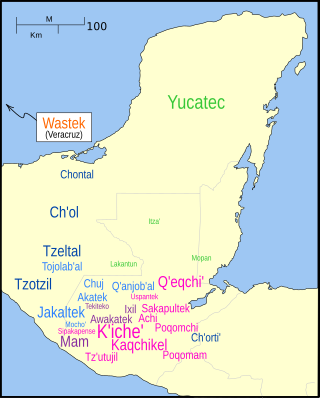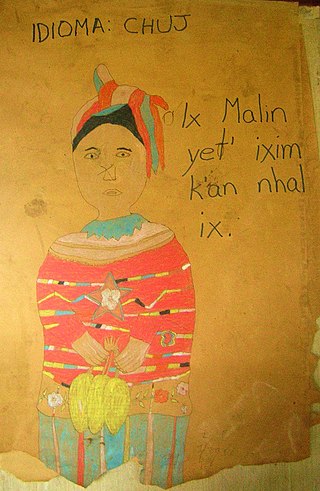In linguistic typology, split ergativity is a feature of certain languages where some constructions use ergative syntax and morphology, but other constructions show another pattern, usually nominative–accusative. The conditions in which ergative constructions are used vary among different languages.
Hurrian is an extinct Hurro-Urartian language spoken by the Hurrians (Khurrites), a people who entered northern Mesopotamia around 2300 BC and had mostly vanished by 1000 BC. Hurrian was the language of the Mitanni kingdom in northern Mesopotamia and was likely spoken at least initially in Hurrian settlements in modern-day Syria.
In linguistic typology, ergative–absolutive alignment is a type of morphosyntactic alignment in which the single argument ("subject") of an intransitive verb behaves like the object of a transitive verb, and differently from the agent ("subject") of a transitive verb. Examples include Basque, Georgian, Mayan, Tibetan, and certain Indo-European languages. It has also been attributed to the Semitic modern Aramaic languages. Ergative languages are classified into 2 groups: those that are morphologically ergative but syntactically behave as accusative and those that—on top of being ergative morphologically—also show ergativity in syntax. No language has been recorded in which both the morphological and syntactical ergative are present. Languages that belong to the former group are more numerous than those to the latter. Dyirbal is said to be the only representative of syntactic ergativity, yet it displays accusative alignment with certain pronouns.

Greenlandic is an Eskimo–Aleut language with about 57,000 speakers, mostly Greenlandic Inuit in Greenland. It is closely related to the Inuit languages in Canada such as Inuktitut. It is the most widely spoken Eskimo–Aleut language. In June 2009, the government of Greenland, the Naalakkersuisut, made Greenlandic the sole official language of the autonomous territory, to strengthen it in the face of competition from the colonial language, Danish. The main variety is Kalaallisut, or West Greenlandic. The second variety is Tunumiit oraasiat, or East Greenlandic. The language of the Inughuit of Greenland, Inuktun or Polar Eskimo, is a recent arrival and a dialect of Inuktitut.
The Ch'ol (Chol) language is a member of the western branch of the Mayan language family used by the Ch'ol people in the states of Chiapas, Tabasco, and Campeche in Mexico. This language, together with Chontal, Ch'orti', and Ch'olti', constitute the Cholan language group.

Tzeltal or Tseltal is a Mayan language spoken in the Mexican state of Chiapas, mostly in the municipalities of Ocosingo, Altamirano, Huixtán, Tenejapa, Yajalón, Chanal, Sitalá, Amatenango del Valle, Socoltenango, Las Rosas, Chilón, San Juan Cancuc, San Cristóbal de las Casas and Oxchuc. Tzeltal is one of many Mayan languages spoken near this eastern region of Chiapas, including Tzotzil, Chʼol, and Tojolabʼal, among others. There is also a small Tzeltal diaspora in other parts of Mexico and the United States, primarily as a result of unfavorable economic conditions in Chiapas.

Alyutor or Alutor is a language of Russia that belongs to the Chukotkan branch of the Chukotko-Kamchatkan languages.
The Chʼortiʼ language is a Mayan language, spoken by the indigenous Maya people who are also known as the Chʼortiʼ or Chʼortiʼ Maya. Chʼortiʼ is a direct descendant of the Classic Maya language in which many of the pre-Columbian inscriptions using the Maya script were written. Chʼortiʼ is the modern version of the ancient Mayan language Chʼolan.
Georgian grammar has many distinctive and extremely complex features, such as split ergativity and a polypersonal verb agreement system.
The Kaqchikel language is an indigenous Mesoamerican language and a member of the Quichean–Mamean branch of the Mayan languages family. It is spoken by the indigenous Kaqchikel people in central Guatemala. It is closely related to the Kʼicheʼ (Quiché) and Tzʼutujil languages.

Chuj is a Mayan language spoken by around 40,000 members of the Chuj people in Guatemala and around 3,000 members in Mexico. Chuj is a member of the Qʼanjobʼalan branch along with the languages of Tojolabʼal, Qʼanjobʼal, Akateko, Poptiʼ, and Mochoʼ which, together with the Chʼolan branch, Chuj forms the Western branch of the Mayan family. The Chujean branch emerged approximately 2,000 years ago. In Guatemala, Chuj speakers mainly reside in the municipalities of San Mateo Ixtatán, San Sebastián Coatán and Nentón in the Huehuetenango Department. Some communities in Barillas and Ixcán also speak Chuj. The two main dialects of Chuj are the San Mateo Ixtatán dialect and the San Sebastián Coatán dialect.

Hindustani, the lingua franca of Northern India and Pakistan, has two standardised registers: Hindi and Urdu. Grammatical differences between the two standards are minor but each uses its own script: Hindi uses Devanagari while Urdu uses an extended form of the Perso-Arabic script, typically in the Nastaʿlīq style.
Hunzib is a Northeast Caucasian language spoken by the Hunzib people in southern Dagestan, near the Russian border with Georgia.
Qʼanjobʼal is a Mayan language from the Q'anjobalan branch spoken primarily in Guatemala and part of Mexico. According to 1998 estimates compiled by SIL International in Ethnologue, there were approximately 77,700 native speakers, primarily in the Huehuetenango Department of Guatemala. In Chiapas, Mexico, municipalities where the Qʼanjobʼal language is spoken include Catazajá, Amatenango de la Frontera, La Trinitaria, Bella Vista, Frontera Comalapa, Las Margaritas and Maravilla Tenejapa. In Huehuetenango, the municipalities where the language is spoken are San Juan Ixcoy, San Pedro Soloma, Santa Eulalia, Santa Cruz Barillas (Yalmotx), San Rafael La Independencia, and San Miguel Acatán. Qʼanjobʼal is taught in public schools through Guatemala's intercultural bilingual education programs.
Roviana is a member of the North West Solomonic branch of Oceanic languages. It is spoken around Roviana and Vonavona lagoons at the north central New Georgia in the Solomon Islands. It has 10,000 first-language speakers and an additional 16,000 people mostly over 30 years old speak it as a second language. In the past, Roviana was widely used as a trade language and further used as a lingua franca, especially for church purposes in the Western Province, but now it is being replaced by the Solomon Islands Pijin. Published studies on Roviana include: Ray (1926), Waterhouse (1949) and Todd (1978) contain the syntax of Roviana. Corston-Oliver discuss ergativity in Roviana. Todd (2000) and Ross (1988) discuss the clause structure in Roviana. Schuelke (2020) discusses grammatical relations and syntactic ergativity in Roviana.
Central Alaskan Yupʼik is one of the languages of the Yupik family, in turn a member of the Eskimo–Aleut language group, spoken in western and southwestern Alaska. Both in ethnic population and in number of speakers, the Central Alaskan Yupik people form the largest group among Alaska Natives. As of 2010 Yupʼik was, after Navajo, the second most spoken aboriginal language in the United States. Yupʼik should not be confused with the related language Central Siberian Yupik spoken in Chukotka and St. Lawrence Island, nor Naukan Yupik likewise spoken in Chukotka.
Chirag is a language in the Dargin dialect continuum spoken in Dagestan, Russia. It is often considered a divergent dialect of Dargwa. Ethnologue lists it under the dialects of Dargwa but recognizes that it may be a separate language.
Aramba (Arammba), also known as Serki or Serkisetavi, is a Papuan language of Papua New Guinea. It is spoken to the south of Western Province in the Trans Fly region. Aramba belongs to the Tonda Sub-Family, which is next to the Nambu Sub-Family region and the Suki language. Alternative names for the language include Upper Morehead, Rouku, Kamindjo and Tjokwasi.
Mẽbêngôkre, sometimes referred to as Kayapó is a Northern Jê language spoken by the Kayapó and the Xikrin people in the north of Mato Grosso and Pará in Brazil. There are around 8,600 native speakers since 2010 based on the 2015 Ethnologue 18th edition. Due to the number of speakers and the influence of Portuguese speakers, the language stands at a sixth level of endangerment; in which the materials for literacy and education in Mẽbêngôkre are very limited.

Kʼicheʼ, or Quiché, is a Mayan language spoken by the Kʼicheʼ people of the central highlands in Guatemala and Mexico. With over a million speakers, Kʼicheʼ is the second most widely-spoken language in the country, after Spanish. It is one of the most widely-spoken indigenous American languages in Mesoamerica.





